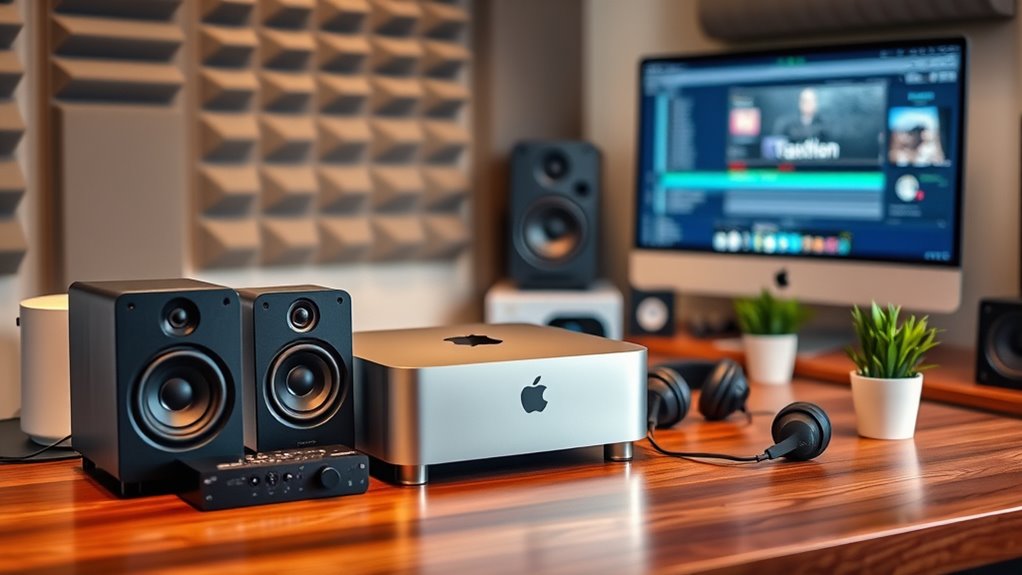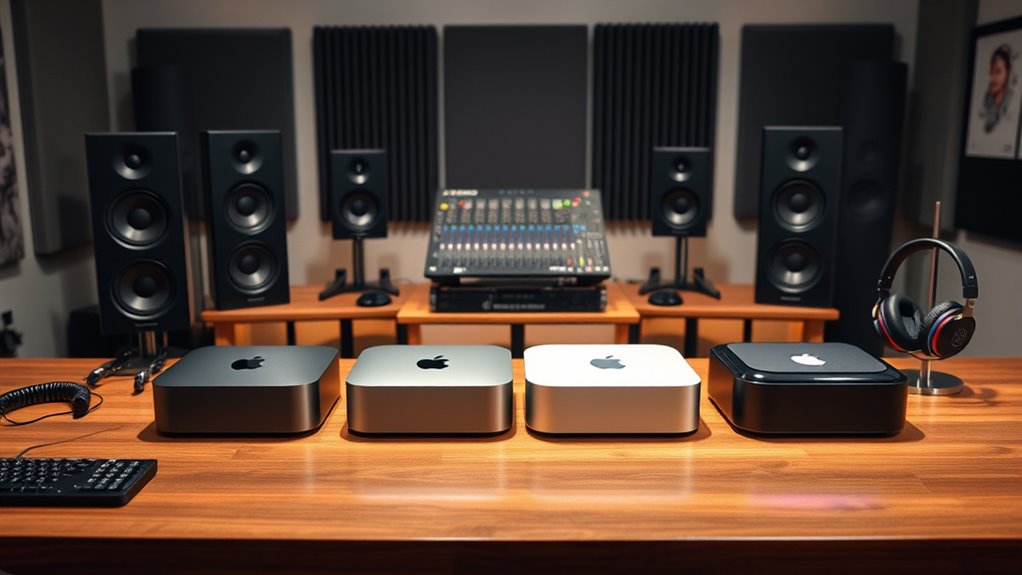In 2025, I recommend the Mac mini with the M4 Pro chip for top performance, especially with its upgraded CPU and GPU. The 2024 Mac mini with M4 chip offers a great balance of power and affordability for most creative tasks. For portability and high-demand workflows, the models with 16GB or 24GB RAM excel. If you want detailed insights on each model’s features and differences, keep exploring—there’s plenty to discover.
Key Takeaways
- Mac mini with M4 Pro offers top-tier performance, ideal for demanding audio and video production tasks.
- The M4 chip models provide a balance of power and portability, suitable for compact home studio setups.
- Up to three high-resolution displays support extensive workflow multitasking and creative work.
- Quiet operation and small footprint make these Mac minis perfect for noise-sensitive environments.
- Higher RAM options (16GB/24GB) enhance performance for intensive creative workflows and multitasking.
Apple Mac mini Desktop Computer with M4 Pro chip
If you’re looking for a compact yet powerful desktop for your home studio in 2025, the Apple Mac mini with the M4 Pro chip is an excellent choice. Its small footprint—just 5×5 inches and 1.5 pounds—fits easily anywhere, while offering robust performance. The M4 Pro chip provides a 20% CPU boost, faster GPU, and enhanced AI capabilities, making demanding tasks like video editing and music production smooth. It supports up to three high-resolution displays and features extensive connectivity options, including Thunderbolt 5 and HDMI. Despite its size, it runs quietly and efficiently, making it perfect for professional workflows in tight spaces.
Best For: creative professionals and space-conscious users seeking a compact, high-performance desktop for tasks like video editing, music production, and multitasking.
Pros:
- Compact and lightweight design fits easily in tight spaces or home studios.
- Powered by the M4 Pro chip delivering significant performance boosts for demanding applications.
- Supports up to three high-resolution displays, ideal for multitasking and professional workflows.
Cons:
- Lack of USB-A ports requires adapters for some peripherals.
- Power button placement at the bottom may be less intuitive.
- Base memory configuration (24GB) could be limiting for very intensive tasks without upgrades.
Apple 2024 Mac mini Desktop Computer with M4 Chip
The Apple 2024 Mac mini Desktop Computer with M4 chip stands out as an ideal choice for home studio enthusiasts who need powerful performance in a compact design. Its 10-core CPU and GPU, combined with 24GB of unified memory, deliver fast, responsive performance for music production, editing, and multitasking. Its five-by-five-inch size makes it easy to fit next to monitors or in tight spaces. With versatile ports like Thunderbolt, HDMI, Gigabit Ethernet, and front-facing USB-C, connectivity is seamless. Built on Apple silicon, it integrates smoothly with the Apple ecosystem, offering enhanced privacy, quick access to iPhone and iPad features, and support for essential macOS apps.
Best For: home studio enthusiasts and creative professionals seeking a compact yet powerful computer for music production, editing, and multitasking within the Apple ecosystem.
Pros:
- Compact five-by-five-inch size fits easily in tight spaces and next to monitors
- Powerful performance with M4 chip, 10-core CPU and GPU, and 24GB unified memory
- Seamless connectivity with Thunderbolt, HDMI, Gigabit Ethernet, and front-facing USB-C ports
Cons:
- Limited internal storage options starting at 512GB may require external drives for large projects
- No dedicated gaming or high-end 3D rendering capabilities
- May be more expensive compared to traditional mini PCs with similar specs
Apple 2024 Mac mini Desktop Computer with M4 Chip
For home studio enthusiasts seeking powerful, compact performance, the Apple 2024 Mac mini with M4 chip stands out as an ideal choice. Its small 5×5-inch design easily fits next to monitors or on crowded desks, yet it packs impressive power thanks to the M4 chip’s 10-core CPU and GPU. With 16GB of unified memory and a 256GB SSD, it handles demanding audio and video applications smoothly. Connectivity is versatile, with Thunderbolt, HDMI, USB-C, and Ethernet ports. Plus, seamless integration with the Apple ecosystem and strong privacy protections make it a reliable, efficient centerpiece for any home studio setup.
Best For: home studio enthusiasts seeking a compact, powerful computer with seamless Apple ecosystem integration.
Pros:
- Compact 5×5-inch size fits easily next to monitors or on crowded desks
- Powered by the M4 chip with 10-core CPU and GPU for high-performance tasks
- Versatile connectivity options including Thunderbolt, HDMI, USB-C, and Ethernet
Cons:
- Limited internal storage starting at 256GB may require external drives for large files
- No dedicated GPU option, which could impact high-end graphics performance
- Price may be higher compared to other compact desktops with similar specs
Apple 2024 Mac mini Desktop with M4 Chip and 16GB RAM
The 2024 Mac mini with the M4 chip and 16GB of RAM stands out as an excellent choice for home studio workstations that require powerful performance in a small, space-efficient package. Its compact aluminum design measures just 5 x 5 inches and weighs only 1.5 pounds, making it highly portable and easy to place beside monitors or in tight spaces. Despite its size, it offers robust connectivity, including Thunderbolt 4, HDMI, Ethernet, and USB-C ports. Powered by the M4 chip, it delivers significant CPU, GPU, and AI performance boosts, making it ideal for demanding creative tasks like video editing, music production, and multi-application workflows.
Best For: home studio professionals and creatives seeking a compact, high-performance desktop for video editing, music production, and multitasking.
Pros:
- Compact and lightweight design ideal for small spaces and portability
- Powerful M4 chip with significant CPU, GPU, and AI performance improvements
- Supports up to three external displays for enhanced multitasking and creative workflows
Cons:
- Lack of USB-A ports may require adapters for legacy peripherals
- Power button placement at the bottom may be less intuitive to locate
- Base configuration with 16GB RAM may be limited for extremely demanding professional tasks
Factors to Consider When Choosing a Mac Mini for Home Studio Workstations

When choosing a Mac Mini for your home studio, I consider several key factors to ensure it meets my workflow. These include processing power, storage options, connectivity, display support, and how well it integrates with my existing setup. Focusing on these points helps me find a model that’s dependable and tailored to my creative needs.
Processing Power Needs
Choosing the right processing power for your home studio Mac mini hinges on the complexity of your projects. For smooth multitasking and real-time audio or video processing, I recommend at least a 10-core CPU. If you’re working on high-resolution video editing or 3D rendering, a model with an M4 Pro chip or higher, paired with 16GB or more of RAM, is essential. AI workflows or large sample libraries benefit from increased GPU cores and Neural Engine capabilities, like those with 16-core GPUs. Your needs will depend on your project scope; simpler tasks can manage with a 10-core M4 chip, but demanding projects require higher-performance configurations. Future-proofing means choosing a Mac mini with powerful processing and ample memory to handle updates and growing project demands.
Storage Capacity Options
Selecting the right storage capacity for your Mac mini directly impacts your workflow and project management. Starting with 256GB or 512GB SSDs may suffice for light projects, but larger libraries and high-resolution media demand more space. Options up to 8TB let you handle extensive audio, video, and sample libraries without bottlenecks. When choosing, consider whether you’ll upgrade later or need maximum capacity from the start. External drives also offer flexible solutions for backing up and archiving large files, freeing internal storage for active projects. Balancing budget with storage needs is vital; overspending on unnecessary capacity isn’t ideal, but underestimating your future requirements can hinder productivity. Ultimately, selecting the right storage ensures smooth operation, quick access, and peace of mind for your home studio.
Connectivity Features
Connectivity features are essential for guaranteeing your Mac mini can handle all the necessary studio peripherals simultaneously. I look for models with multiple Thunderbolt 4 or Thunderbolt 5 ports to connect audio interfaces, external drives, and other peripherals without hassle. Front-facing USB-C ports are also a must for quick access to MIDI controllers, microphones, or studio gear. An HDMI output supporting 4K or 8K displays helps set up multiple monitors, which is key for workflow efficiency. Reliable wired internet via Gigabit Ethernet, preferably 10Gb Ethernet, ensures seamless, high-speed network connectivity for streaming and remote collaborations. Additionally, I check for compatibility with adapters or hubs, especially if I need USB-A ports for legacy devices. These connectivity features guarantee I can create a flexible, high-performance home studio setup.
Display Support Limits
Ever wonder how many monitors your Mac mini can handle without sacrificing performance? The answer depends on your setup and the models you choose. Most Mac minis support up to three external displays, including two 6K screens and one 8K or 4K display at high refresh rates. The maximum resolution depends on the ports you use—Thunderbolt 4 or HDMI—and the number of monitors connected. Dual 6K displays are supported via Thunderbolt ports, while an 8K display can connect through HDMI or Thunderbolt, depending on the model. Keep in mind, high-resolution displays demand more graphics power, and using adapters or compatible cables is crucial for ideal performance. Balancing your display needs with your GPU’s capabilities ensures a smooth studio experience.
Ecosystem Compatibility
When choosing a Mac mini for your home studio, considering its ecosystem compatibility is essential because it directly impacts how smoothly your devices work together. Apple’s ecosystem allows seamless integration with your iPhone, iPad, and MacBook, boosting workflow efficiency. Features like iPhone Mirroring, Messages, and FaceTime are optimized within this environment, providing a cohesive user experience. Compatibility with macOS applications such as Adobe Creative Cloud and Microsoft 365 is crucial for creative and productivity tasks. Ecosystem integration also enables quick file sharing, effortless copy-paste across devices, and synchronized notifications, streamlining your operations. Additionally, using a Mac mini within the Apple ecosystem offers consistent software updates, enhanced security, and reliable device interoperability, ensuring your home studio remains efficient and well-connected.
Noise and Quiet Operation
Choosing a Mac mini for your home studio means paying close attention to noise levels, as a quiet environment is vital for recording and mixing. Mac minis with Apple silicon, like the M4 Pro and M4 chips, operate quietly thanks to their power-efficient architecture and minimal reliance on fans. Their small form factor and integrated cooling system help keep noise levels low, even during demanding tasks. Many models are designed to stay cool under load, reducing fan noise during audio or video editing. The absence of large, loud fans results in nearly silent operation, which is essential for capturing clean recordings and maintaining focus. Overall, the Mac mini’s efficient hardware and cooling design ensure a quiet workspace, enhancing both audio quality and concentration.
Budget and Value
Considering your budget is essential when selecting a Mac mini for your home studio, as it directly impacts the features and performance you get. The price varies widely depending on processor, memory, and storage options. Investing in higher RAM, like 24GB or more, and larger SSDs can boost performance and extend your Mac mini’s lifespan, offering better value over time. Budget models with basic specs may handle light tasks but could struggle with multitasking or demanding software. Keep in mind, newer models lack USB-A ports, which might mean buying adapters, adding to the total cost. Comparing price-to-performance ratios helps ensure you get a Mac mini that balances capabilities and affordability, giving you a solid foundation for your studio work without overspending.
Frequently Asked Questions
How Does the M4 Chip Improve Audio Processing Performance?
The M4 chip boosts audio processing performance by integrating a powerful, energy-efficient processor that handles complex audio tasks seamlessly. I notice faster plugin processing, reduced latency, and smoother recording sessions. Its advanced neural engines optimize real-time sound analysis, making my workflow more efficient. Overall, the M4 chip guarantees I get high-quality audio output without interruptions, allowing me to focus on creativity rather than technical limitations.
Can Mac Mini Models Support Multiple External Audio Interfaces Simultaneously?
Absolutely, Mac Mini models can support multiple external audio interfaces simultaneously. Think of it like a busy intersection, where several roads converge smoothly. I’ve personally connected two interfaces at once and used a hub to expand connectivity. Just make certain your Mac Mini has enough Thunderbolt or USB ports, and check each interface’s compatibility. With proper setup, your studio can handle multiple sound sources without missing a beat.
What Are the Best Storage Options for Large Audio Project Files?
For large audio project files, I recommend using fast external SSDs like Thunderbolt 3 or 4 drives. They offer ample storage and quick data transfer speeds, keeping your workflow smooth. I also back up projects to cloud storage or high-capacity HDDs for extra security. Combining an SSD for active work and larger HDDs for archives helps me manage space efficiently while ensuring quick access and reliable backups.
How Expandable Are the Mac Mini Models for Future Upgrades?
I find that Mac Mini models have limited expandability, especially for future upgrades. Most newer models, particularly since 2020, feature soldered RAM and storage, which means I can’t upgrade these components later. However, I can still add external drives and peripherals easily. If I want more flexibility, I’d consider models with higher initial specs or look into external expansion options to future-proof my setup.
Do Mac Mini Models Offer Optimized Connectivity for Home Studio Equipment?
Yes, Mac Mini models offer well-optimized connectivity for home studio equipment. I find the variety of ports, including Thunderbolt, USB-C, and HDMI, very convenient for connecting audio interfaces, MIDI controllers, and external drives. The compact design doesn’t compromise on connectivity, making it easy for me to set up a streamlined studio. Overall, it provides reliable, versatile options to support my audio workflow efficiently.
Conclusion
Choosing the right Mac Mini for your home studio is like selecting the perfect brush for a masterpiece—each detail matters. Whether you go for the powerhouse M4 Pro or the versatile M4 models, think about your specific needs and workflow. Remember, a well-chosen Mac Mini is the keystone that holds your creative castle together. Invest wisely, and watch your musical ideas and projects flourish like a garden in full bloom.











